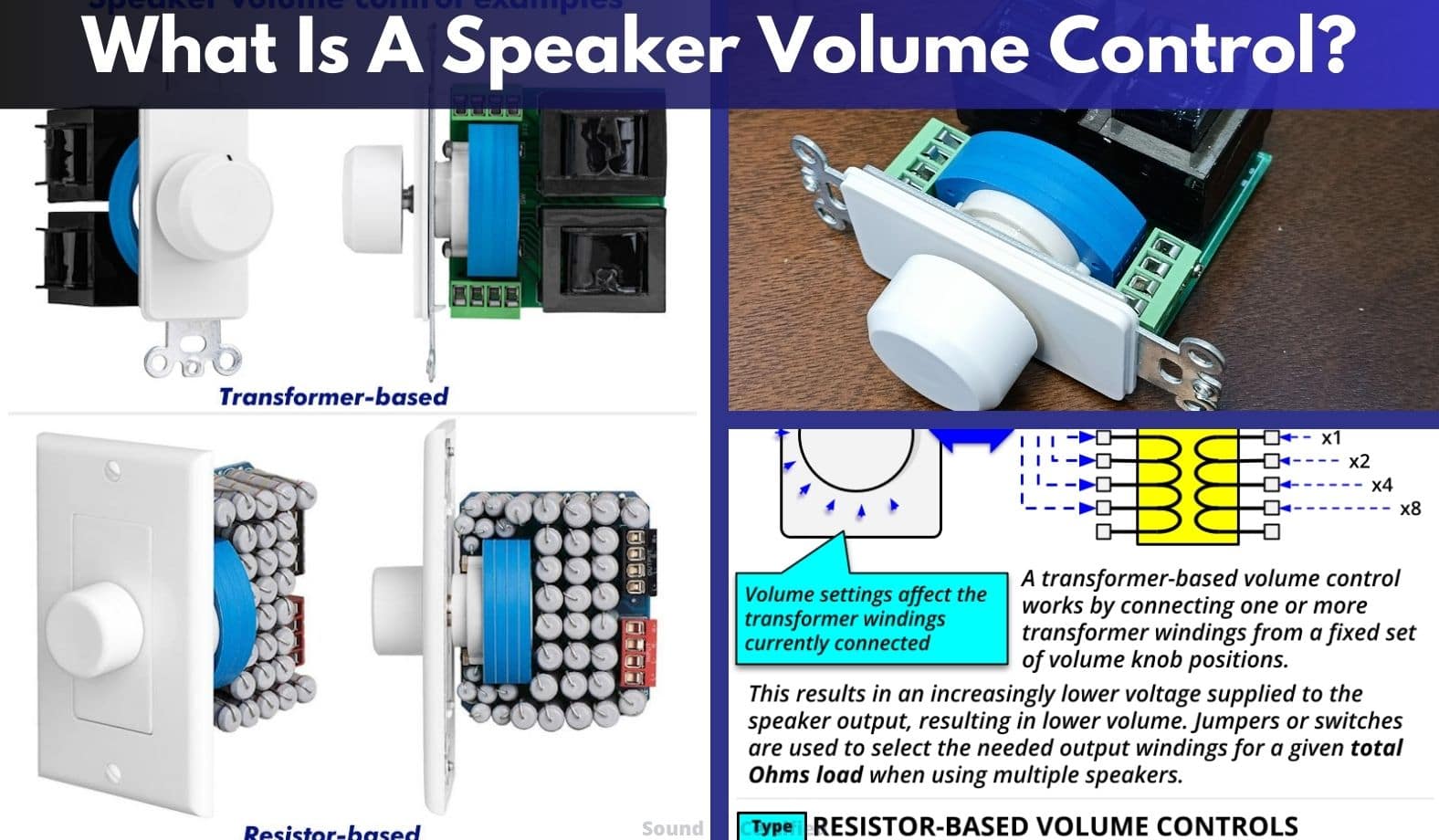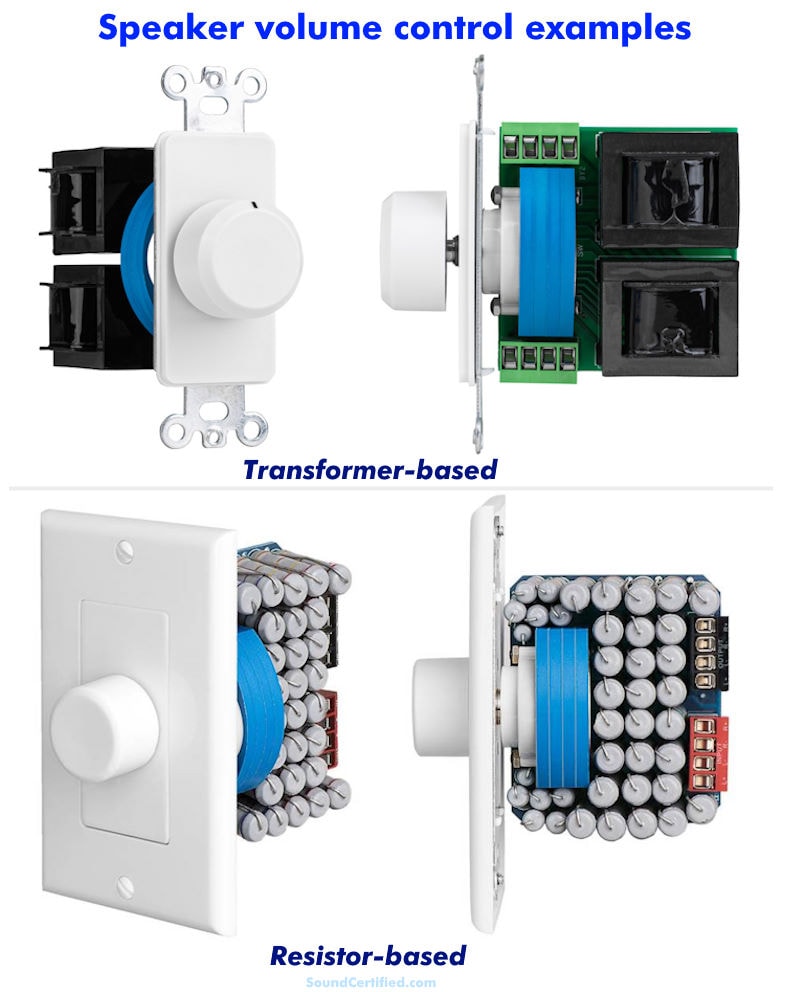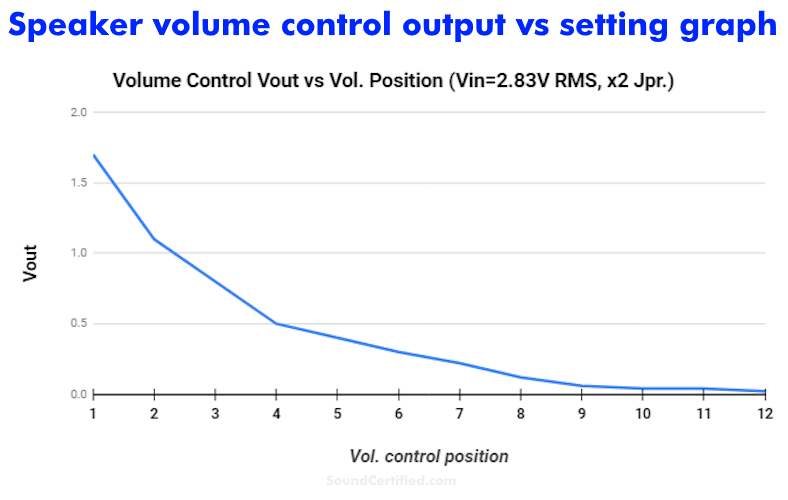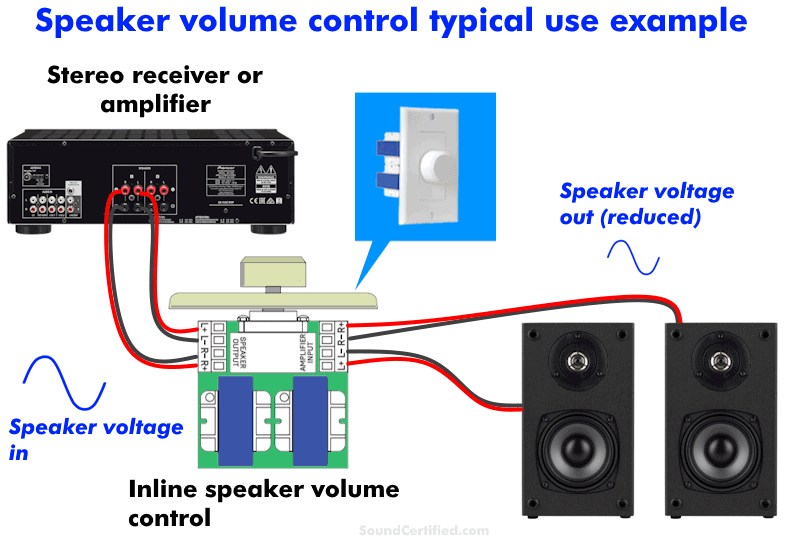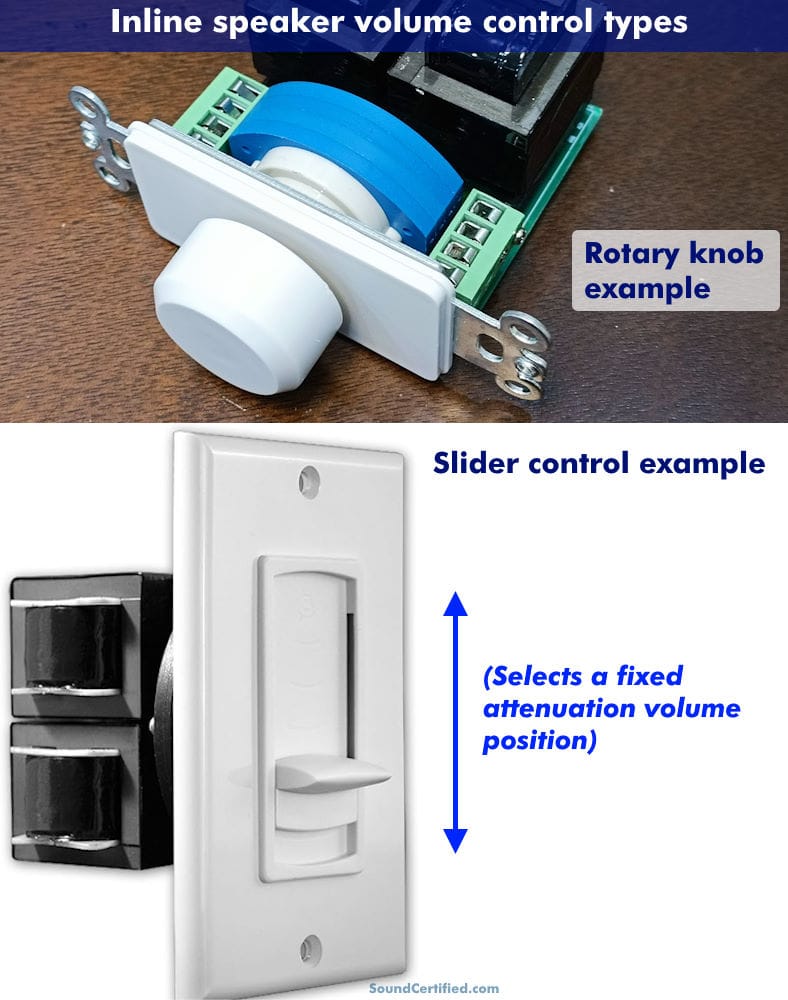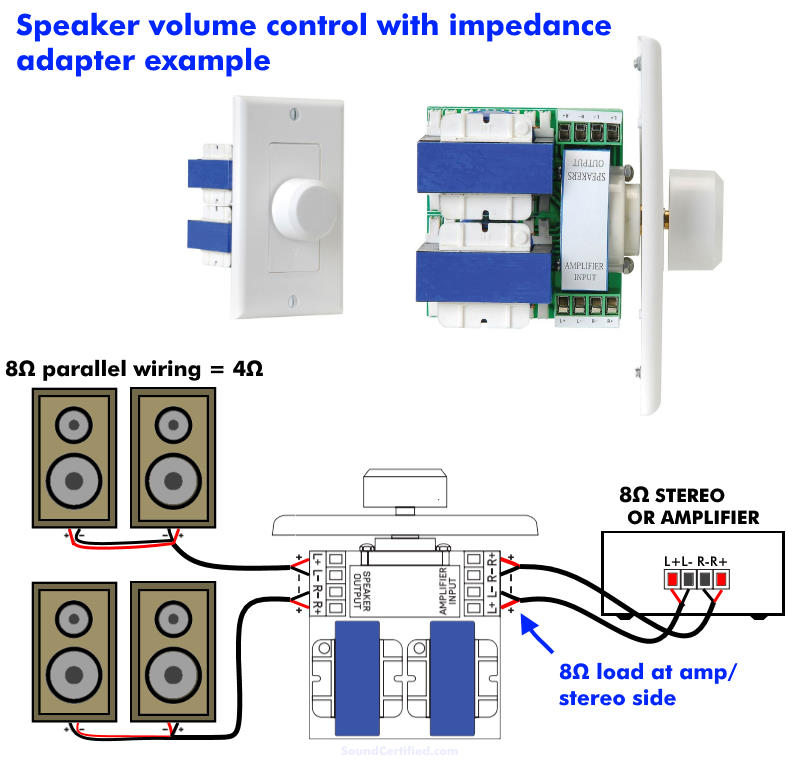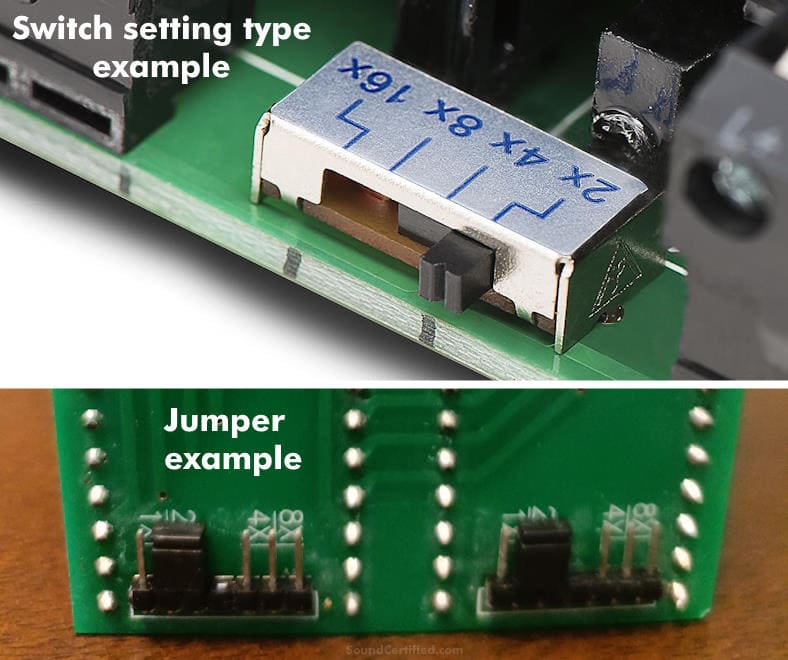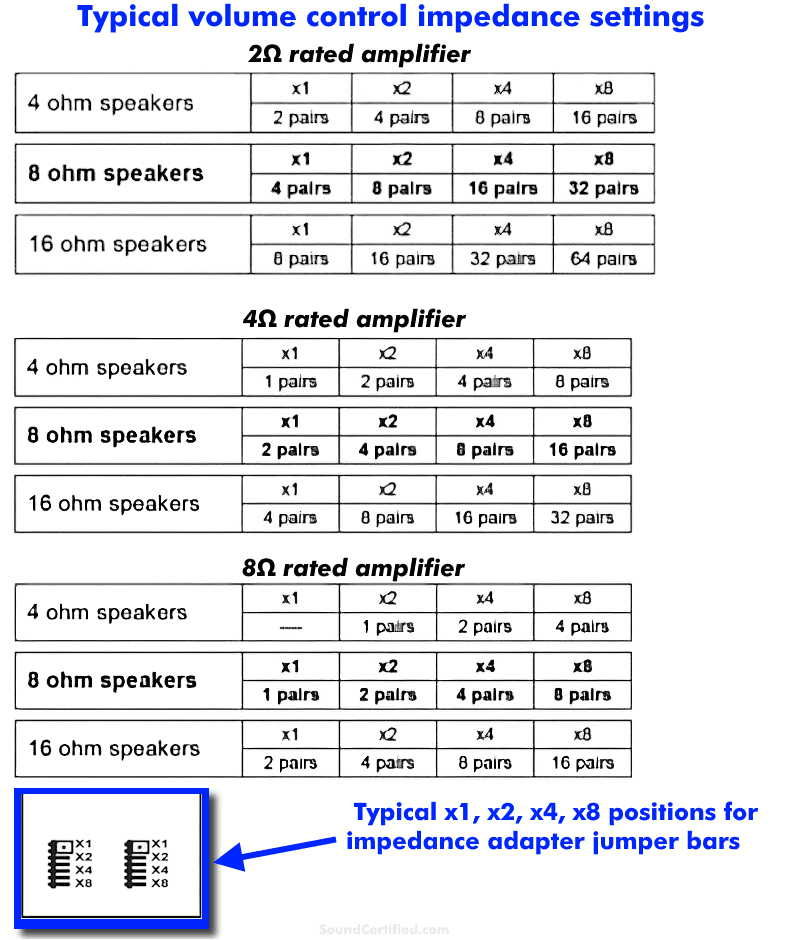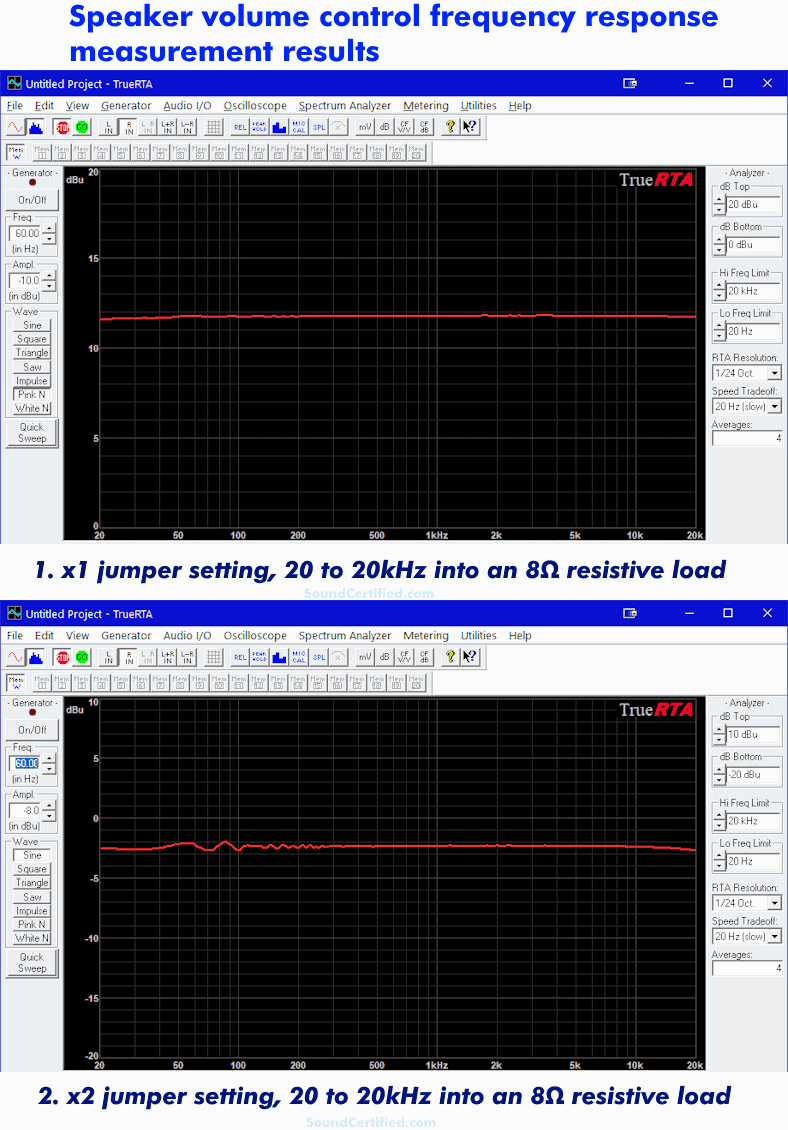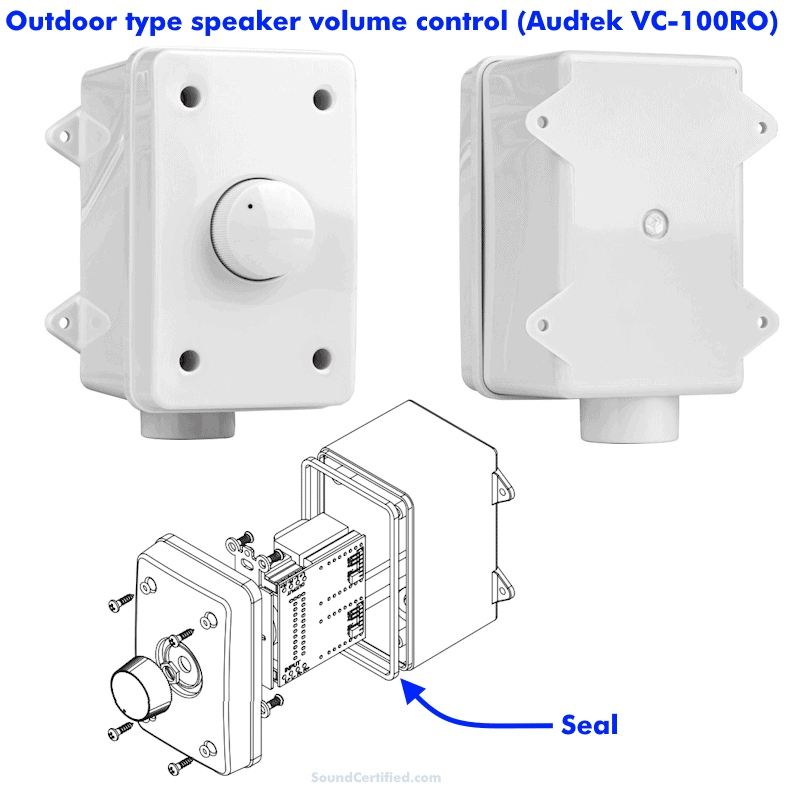In this article, I’ll explain inline speaker volume controls and cover many topics:
- How they work to reduce speaker volume
- The different types and pros and cons of each
- What a speaker impedance adapter feature is and how they’re helpful
- Sound quality issues to be aware of
…and much more!
Contents
What is an inline speaker volume control?
An inline speaker volume control is a device that lowers speaker volume by reducing the power delivered to a speaker or stereo speaker system. They are passive (non-powered) devices connected between stereo receiver or amplifier speaker outputs and the speaker pair.
The volume controller works by reducing the speaker signal voltage supplied by the AV receiver or amplifier. This results in the speaker voice coil developing less power, creating a lower sound pressure level, and lower volume level output. It’s similar in a few ways to how a line output converter works to reduce speaker signals for amplifier use.
Image shown: A graph showing how the input test speaker voltage compares to the output I measured throughout the volume adjustment range. (Note that these are 3dB, 6dB, and final fully-off stepped outputs).
Typical units use a fixed set of volume adjustment positions (or “steps”), with 12 positions being very common. That’s similar to some speaker selector units that offer volume control features. However, those are larger and some don’t have a good range of listening volumes.
It’s important to buy a model with the correct power rating as they do have limits as to how much they can handle. Typical power ratings are 50 watts per channel, 100W, and 300W or similar.
The good is that they’re not expensive, either, despite their usefulness. A common affordable volume control is a little as about $19 USD and up to less than $50 for higher power models.
How are inline speaker volume controls used?
Some application examples are:
- Adding speakers to additional rooms and a way to control the sound level away from the source stereo.
- Adding multiple patio or pool speakers along with a convenient volume control.
- Upgrading your home stereo listening experience with additional speaker pairs by way of the impedance adapter feature.
Basic volume control installation is pretty simple to install:
- Speaker wire is connected from the stereo amplifier or receiver to the speaker input connector.
- Speaker wire is then connected from the speaker output connector to the speaker system.
- Impedance matching volume control models need to have switches or jumpers set for the correct speaker impedance rating and how many speaker pair sets are connected (I’ll cover this later).
Most provide speaker terminal connectors with tension screws, making installation as an in-wall volume control simple Most sold today are designed to fit in a standard electrical wiring junction box similar to a wall light switch or electrical outlet.
As no power supply is required it’s basically just a matter of connecting the speaker wire you’re using. Outdoor models work the same way and are often preinstalled in a moisture-resistant enclosure and are ready to mount to a flat surface.
Types of speaker volume controls
- Transformer-based volume controls – These use audio-qualified transformers, one per channel, made up of multiple input side and output side windings. Unlike resistor-based units, they don’t waste any supplied speaker power. These also have the additional benefit of impedance adapter functions as well, allowing for more speakers to be used than is normally possible.
- Resistor-based volume controls – Resistor units use simple multi-resistor selection circuits to drop the power and voltage to speakers. They’re lighter and more compact in many cases. They’re also ideal for high-fidelity sound as they have a perfectly flat frequency response, unlike transformers.
Volume control styles
- Rotary knob – This type is often the most common you’ll find, and uses a volume control knob that turns and selects a volume reduction indentation.
- Slider controls – Sliders use the same basic design as knob types but select a volume step vertically rather than by rotating.
Separate ground feature
You may notice that some models state “Independent grounds for use with any amplifier” or similar in their description. This means the ground (negative) speaker channel connections are isolated from each other, avoiding problems with undesirable current flowing between speaker outputs – or even a short circuit!
This makes it possible to use two separate single amplifier per each channel if needed.
How does an inline speaker volume control work?
As I mentioned earlier, a volume controller works by reducing the power delivered to the connected speaker system. However, the way this is done is very different between the two main types. However, in most cases the rotary knob affects both stereo channels at once and doesn’t offer independent volume control.
Transformer based volume reduction
This type uses a multiple-circuit switch to make or break a number of connections between the input speaker terminals and one or more windings on the primary (first) side of the transformer. These transformers, one per stereo channel, work as step-down transformers, meaning that they use secondary (output) windings with a lower number of turns which results in a lower output voltage.
As the primary winding is supplied a signal from the amp or AV receiver, the current flowing creates electromagnetic fields. These fields induce an identical signal with lower voltage in the secondary winding side output.
Each master volume knob position connects one or more transformer windings, resulting in a lower and lower speaker level output as the volume knob is turned. The speakers then receive less and less power, resulting in lower and lower volume output.
This same voltage reduction principle is used in many 120V or 220V appliances in your home.
Transformer type pros and cons
This type doesn’t waste any speaker power as it’s simply carried over to the output side unlike resistor types. Most models use a set of switches or jumpers to set the initial output level based on the speaker Ohms load in use (for example, x1 being typically used for 8 Ohm speakers).
This type (unlike resistor-based designs) offers impedance matching options which can be extremely helpful. However, as you’ll see later they can have minor losses in the audio signal performance sometimes.
Resistor based volume reduction
Similar to the transformer type, these also use a multiple-circuit rotary control but are based on a simpler design. The printed circuit board (PCB) has multiple power resistors of various resistance values connected to the volume switch outputs in line with the speaker output terminals.
When a volume reduction step is selected, one or more resistors are connected in series with each speaker, reducing the power it receives and thereby lowering the volume. A portion of the supplied amplifier power is lost across the power resistors as heat.
Resistor model pros and cons
This is unlike transformer-based models which don’t lose any power as heat. Resistor-based types have the benefit of a perfectly flat frequency response unlike some transformer types.
One major drawback is they don’t offer the impedance matching feature so they’re not helpful for using mismatched speaker impedances or multiple pairs of speakers.
What is impedance matching on a volume control?
An impedance matching adapter makes it possible to connect multiple speakers or speakers of a lower impedance than is normally possible. This is done by changing the speaker voltage on the output side in order to maintain a safe current draw at the input side.
The end result is that the stereo amplifier or receiver “sees” a safe total Ohms load and doesn’t attempt to supply more current than it’s rated for. Overcurrent is the condition that overheats and permanently damages the output stages of an amp or stereo when a total speaker load is lower than it’s rated for.
This feature is commonly found in transformer-based models as by design it’s possible to conveniently make use of existing step-down windings to achieve this. To do so, the circuit board includes front-mounted adjustable jumpers or switches used to choose a predetermined range of speaker Ohms and/or number of speaker pairs in use.
These are typically labeled as “x1” (no impedance adapting used – direct output), “x2”, “x4”, “x6”, and so on. The manufacturer supplies a selection table which can be used to pick the jumper or switch selection you’ll need.
This makes it possible to use multiple pairs of 16 Ohm, 8 Ohm, 6 Ohm, 4 Ohm, and even 2 Ohm speakers!
Does an inline volume control affect sound quality?
Image shown: Frequency response graphs I measured for the Audtek VC-50R 50 watt transformer type speaker volume controller. As you can see, the performance is very good – within less than +/-2dB sound loss across the entire audio range, depending on the selected volume setting.
Generally speaking, inline volume controls have good sound quality. However, it depends on the following:
- Resistor based models have essentially no effect on sound quality, so they’re ideal for audiophile-type projects.
- Good quality transformer types can have very good sound quality, with a slightly non-flat frequency response. This depends greatly on the design and product quality.
- Mediocre quality models can affect the upper (treble) and lower (bass) audio frequency ranges by several decibels – enough to affect sound performance in some cases.
In everyday use, for most people, the differences simply can’t be heard unless the performance is poor. That’s especially true for outdoor speaker systems where a volume controller is used, as the outdoor environment makes it especially hard to head minute differences versus house audio systems.
As with other brands, better-performing units will include the audio performance specification, usually written as something similar to “Frequency response: 35 Hz to 20kHz (+0/-2db) at rated power.”
The good news is that most won’t make much of a difference in what you hear. If you’re concerned about it, stick with a high-quality volume control brand like Audtek Electronics or others that provide specifications.
Inline speaker volume controls for outdoor speakers
Outdoor models are typically the same as indoor models but are installed in a weather-resistant enclosure and may include a seal and better fasteners. As many feature a round opening at the bottom, it’s possible to attach piping such as PVC for routing your speaker wire in a conduit-style fashion.
They also include ready-made mounting tabs that allow them to be mounted to nearly any flat surface.
Can I use a volume control for car stereo speaker systems?
Yes, transformer-based models can be used with single or multiple 8Ω, 4Ω, and 2 Ohm speakers for car audio or other mobile sound projects. Resistor types are generally only designed for 8Ω speakers so those aren’t a good option.
Additionally, you can mount them in plastic junction boxes available at nearly any home improvement store to make installing them easier.
